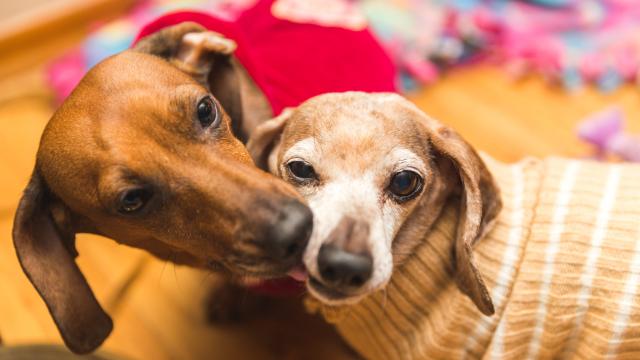Dogs who are past their puppy years may be set in their ways — but that doesn’t mean that training them is a lost cause. Whether you adopt or foster an adult dog, depending on their background, socialising them might be difficult, but it’s not impossible. Signs that your dog is not socialised can be over-excitement around other dogs, aggression or shyness around people, and nervousness during walks. With patience and dedication, you can train almost any dog to be a lot more comfortable in most social situations.
Gradually introduce the dog to social situations
Forcing your older dog into an intense social situation — say, playing with a group of big dogs at the park — could trigger anxiety and negative associations. You want to introduce socialisation gradually, assess what your dog can tolerate, and build on their social skills. The “dog whisperer” Cesar Millan recommends taking your dog on long walks, introducing them to people and other animals at a distance. “Walks are also wonderful for socialising dogs because they’ll have less pent-up energy due to the exercise and should be calmer and more submissive,” says Cesar.
There is more to socialising than being around other dogs and people. The app “pupstanding” offers “100 things in 100 days” — 100 different ways to socialise your dog. Although the list caters to puppies three to four months old, some activities can apply to older dogs. Activities include exposing your dog to sounds, people, sights, surfaces, and handling. With each exercise, you mark whether your dog “hated it” with one star, “meh” or neutral with two stars, and “loved it” with three stars. The stars help you track your dog’s progress.
[referenced id=”1038918″ url=”https://www.lifehacker.com.au/2020/12/how-to-safely-take-car-rides-with-your-dog/” thumb=”https://www.gizmodo.com.au/wp-content/uploads/sites/4/2020/12/04/anlmva874klfm5bd82am-300×169.jpg” title=”How to Safely Take Car Rides With Your Dog” excerpt=”Travelling with your dog can eliminate the stress of kennels or paying someone to dog sit, and as more people are opting for long drives instead of flying, there are few things worth considering when bringing your dog along for the ride. I spoke with Gabriel Riesco, founder of Pawmos…”]
“Introduce new things at the lowest intensity or at a distance,” the app recommends. Once your dog is comfortable at that level, you can gradually increase intensity or decrease the distance. Pay attention to the dog’s stress level as you do this to gauge their progress. Signs of stress can be ears back, tail tucked, and even yawning and licking their lips. Stay alert to your dog’s reactions, so you do not create a hostile environment as you socialise your dog. Loving it or feeling neutral is the goal.
Create a positive environment
Positive reinforcement works on older pets, just as it does with a puppy. As you increase your dog’s socialisation, they will need to know that what is happening around them is good — so reward them with treats or positive interaction. Find out what puts your dog in a good mood, whether it’s food, their favourite toy, or just loving talk or touch. Offer this when they make progress in socialisation. Jason Nicholas on Preventive Vet notes:
Just be sure that, whatever rewards and reinforcers you use, they’re not so distracting as to take their mind completely off their surroundings — as they do need to be aware of their surroundings, to some degree, to become more comfortable with them.
It may take more time to acclimate the dog to any given interaction; your patience is integral to success. Your dog may start tolerating closer interactions with kids at the park, but hide every time you have guests at your house. Signs of anxiety mean they’re not ready for the family barbecue, so be open to taking steps backward in the process. Reintroduce a positive environment by creating distance again and gradually increase interaction like before, and you will progress in time.
[referenced id=”1027818″ url=”https://www.lifehacker.com.au/2020/09/how-to-handle-your-pets-allergies/” thumb=”https://www.gizmodo.com.au/wp-content/uploads/sites/4/2020/09/23/zfimtmf0qtg22bjthnln-300×169.jpg” title=”How to Handle Your Pet’s Allergies” excerpt=”Allergies to animals are a bummer at best (no puppy cuddles for you!) and life-threatening at worst. Research suggests that up to 20% of people worldwide are allergic to dogs and/or cats — but there’s a growing number of animals being treated for allergies of their own.”]
Curb your enthusiasm
Your dog does not think like a person, and they may not respond the way you expect. Dogs primarily react with instincts and energy, while people react with emotions and dialogue. Don’t try to create the exact outcome you want from your dog; instead, be flexible and work with your dog’s capabilities as you discover them. If every time you use a hammer your dog shows signs of obvious distress, no matter the level of exposure, you may need to distance your dog from this activity altogether. Similarly, there may be some activities they will never like, no matter how much fun you think they’ll have. Stay calm, take one activity at a time, and be patient.
Consult an expert when needed
Cesar is not the only dog whisperer — you can find someone with specialised training to help your older dog get social. Adult dogs can have traumatic histories that make socialising challenging without trained help. The ASPCA’s detailed article “Behavioural Help for Your Pet” can help you find the right type of trainer for your dog’s needs. The Association of Professional Dog Trainers also offers a search engine to find trainers in your area.

Leave a Reply
You must be logged in to post a comment.